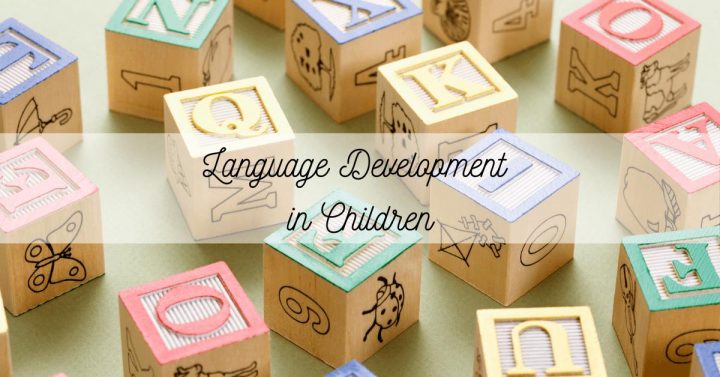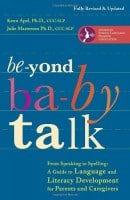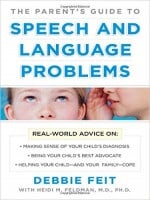
Language and communication skills are critical to a child’s development. Good communication makes them better able to engage in socialization as well as learn from formal classroom instruction and the environment around them.
Communication involves both speech and language. Speech is the verbal means of communication, and language is using shared rules to put words together to express thoughts and feelings. Since parents are a child’s first teacher, knowledge of language development in children improves a parent’s ability to interact with their child to stimulate and guide them to understand and communicate with their environment.
There are four main components of language:
- Phonology involves the rules about the structure and sequence of speech sounds. Semantics consists of vocabulary and how concepts are expressed through words.
- Grammar involves two parts. The first, syntax, is the rules in which words are arranged into sentences. The second, morphology, is the use of grammatical markers (indicating tense, active or passive voice, etc.).
- Pragmatics involves the rules for appropriate and effective communication. Pragmatics involves three skills:
- using language for greeting, demanding, etc.
- changing language for talking differently depending on who it is you’re talking to
- following rules such as turn-taking and staying on topic
From birth on, children are programmed to develop speech and language. The first five years are most critical, but language development continues throughout early childhood and into adolescence. During the first five years, stimulation of language development is essential as the brain is developing new nerve cells as well as multiple connections between these cells to serve the function of expressive and receptive language. Lack of stimulation during this time could result in a child making slower progress or end up with poor communication skills. Later, we provide some tips for parents on how to help with language development, but some simple suggestions are to spend lots of time talking, singing, and reading to your child.
In the early stages of language development, the brain is programmed to attend to speech sounds and begin to mimic them. Early on, babies like to make sounds up on their own. Later they attempt to repeat sounds and words they’re exposed to from their environment.
Children usually say their first words between nine and 18 months old. The most common first words are either “mama” or “dada.” What’s interesting is no matter what language children are taught, the first words usually reference either mother or father.
By about 18 months, a child usually has a vocabulary of 50 to 150 words. Children at this age begin to put a couple of words together to form a sentence sometimes referred to as “telegraphic speech,” such as “Mommy ball” or “Mommy throw ball.” By two-years-old, they can typically use over 300 words and understand about 1,000 words.
Around three years of age, children begin to use language for all kinds of things. They’re not only trying to get what they want by asking, but they’re also talking about past experiences and even beginning to use it to pretend. By preschool (4 ½) they’re beginning to understand and use the rules of language to express possession of something, connect thoughts and quantify. Their language is becoming more like that of adults.
In elementary school, children continue to expand their use of oral language and are also learning to read a write. As children progress through middle school and high school, they continue to expand their vocabulary, refine their grammatical skills and write in more complexities as well as continue to develop reading comprehension skills.
The tables below describe specific skill development for each stage of development through age 8. Below the developmental timeline, you’ll find information on how you can stimulate and encourage language development as well as information on how to recognize lagging development and what to do about it.
Things Parents Can Do To Stimulate Language Development
Early Years
- Verbally respond to your baby’s vocalizations.
- Talk to your baby.
- Around six months of age, use shared attention and sign language (gestures). Point and name things that they see. Use an exaggerated voice when you describe things. Use feeling words.
- Sing to your child from babyhood until they ask you to stop.
- Have older children make up songs.
- Use songs to communicate things such as time to go to bed, time to clean up, etc.
- Make up songs that are silly or that communicate affirmations related to their positive qualities.
Older Toddler and Preschooler
- Initiate conversations with your child related to recent events and what they’re doing.
- Make up stories along with your child where each contributes. This not only stimulates language, but thinking, creating, and a sense of humor.
- Gradually increase the complexity of grammar and vocabulary you use to communicate.
- Provide children with expanded information about events, as well as things they see and how they feel.
- Read interactively to engage their participation. Ask questions, use dramatic inflections, let them guess what will happen next, point to pictures and describe them, and ask your child to do the same. Learn More About Interactive Reading.
School Age and Beyond
- Keep the conversations going.
- Have family meetings.
- Have dinner together at the table and encourage conversation. =You can use “Thorns & Roses” by each family member sharing one thing that went wrong and one thing that well during the day.
- When you go out to dinner, keep the electronics at home or turned off.
- After seeing a movie or TV show together, talk about what happened.
- Encourage reading. When they finish a book, ask about their thoughts and feelings.
Recognizing Problems
Check out the timelines and look for delays. Remember that there is quite a range of time for the achievement of each milestone. If you feel there is a delay, discuss it with your child’s primary care physician.
- Look for poor eye contact and lack of attention and focus.
- Listen to how they pronounce words. Are they hard to understand?
- Can they understand simple directions?
- Are they having trouble with basic social skills?
- Does your child not seem to be interested in having you read to them?
- Do they repeat what you say or say the same thing over and over?
- Do they lack empathy for the feelings of others?
- Do they avoid conversations?
- Are they only interested in talking or reading about one subject?
- Is your preschooler not engaging in fantasy play? Do they lack a sense of humor?
Language Development Time Lines:
Birth to 6 Months
- Vocalization with intonation
- Responds to his name
- Responds to human voices without visual cues by turning his head and eyes
- Responds appropriately to friendly and angry tones
Six to 12 Months
- Uses one or more words with meaning (this may be a fragment of a word)
- Understands simple instructions, especially if vocal or physical cues are given
- Practices inflection
- Is aware of the social value of speech
12 to 18 Months
- Has a vocabulary of approximately 5-20 words
- Vocabulary made up chiefly of nouns
- Some echolalia (repeating a word or phrase over and over)
- Much jargon with emotional content
- Is able to follow simple commands
18 To 24 Months
- Can name a number of objects common to his surroundings
- Is able to use at least two prepositions, usually chosen from the following: in, on, under
- Combines words into a short sentence—largely noun-verb combinations (mean) length of sentences is given as 1.2 words
- Approximately 2/3 of what a child says should be intelligible
- The vocabulary of approximately 150-300 words
- Rhythm and fluency are often poor
- Volume and pitch of voice are not yet well-controlled
- Can use two pronouns correctly: I, me, and you—although me and I are often confused
- “My” and “mine” are beginning to emerge
- Responds to such commands as “show me your eyes (nose, mouth, hair)”
Two to Three Years
- Use pronouns I, you, and me correctly
- Is using some plurals and past tenses
- Knows at least three prepositions, usually in, on, under
- Knows chief parts of the body and should be able to indicate these if not name them
- Handles three-word sentences easily
- Has around 900-1000 words
- About 90% of what the child says should be intelligible
- Verbs begin to predominate
- Understands most simple questions dealing with his environment and activities
- Relates his experiences so that they can be followed with reason
- Able to reason out such questions as “what must you do when you’re sleepy, hungry, cool, or thirsty?”
- Should be able to give his sex, name, age
- Should not be expected to answer all questions even though he understands what is expected
Three to Four Years
- Knows names of familiar animals
- Can use at least four prepositions or can demonstrate his understanding of their meaning when given commands
- Names common objects in picture books or magazines
- Knows one or more colors
- Can repeat 4 digits when they’re given slowly
- Can usually repeat words of four syllables
- Demonstrates understanding of over and under
- Has most vowels and diphthongs and the consonants p, b, m, w, n well established
- Often indulges in make-believe
- Extensive verbalization as he carries out activities
- Understands such concepts as longer, larger, and when a contrast is presented
- Readily follows simple commands even though the stimulus objects are not in sight
- Much repetition of words, phrases, syllables, and even sounds
Four to Five Years
- Uses possessives
- Uses double negatives
- Joins sentences
- Can answer how, who, and when questions
- Follows up to 4 step directions
- Uses the third person
- Tells simple jokes
- Says his full name
- Knows an average of 900 words
- Shows rapid language development
- Uses sentences that are three to four words long
- Mispronounces 40 percent of speech sounds
- Enjoys listening to stories
- Understands more words than he is able to use
- Asks simple who and what questions
- Tells simple events in sequence
- Demonstrates beginning phonological awareness (hearing and recognizing the sounds of language)
- Uses words to express ideas and feelings
- Usually follows requests and can be reasoned with
Five to Six Years
- In addition to the above consonants these should be mastered: f, v, sh, zh, th, l
- He should have concepts of 7
- Speech should be completely intelligible and socially useful
- Should be able to tell one a rather connected story about a picture, seeing relationships between objects and happenings
Six to Seven Years
- Should have mastered the consonants s-z, r, voiceless th, ch, wh, and the soft g, as in George
- Should handle opposite analogies easily: girl-boy, man-woman, flies-swims, blunt-sharp, short-long, sweet-sour, etc.
- Understands such terms as: alike, different, beginning, end, etc.
- Should be able to tell time to quarter hour
- Should be able to do simple reading and to write or print many words
Seven to Eight Years
- Begins to use reference books
- Enjoys reading aloud
- Enjoys mysteries, adventure stories, and biographies
- Adjusts language and vocabulary to fit an audience, topic, or purpose
- Develops vocabulary from textbooks and personal reading
- Gives precise directions and instructions for more complex activities and tasks
- Tells and retells stories in a formal storytelling format using descriptive language, story elements, and voice to create interest and mood
- Demonstrates effective listening skills by exhibiting appropriate body language
- Uses a variety of simple and compound sentences of varied lengths



